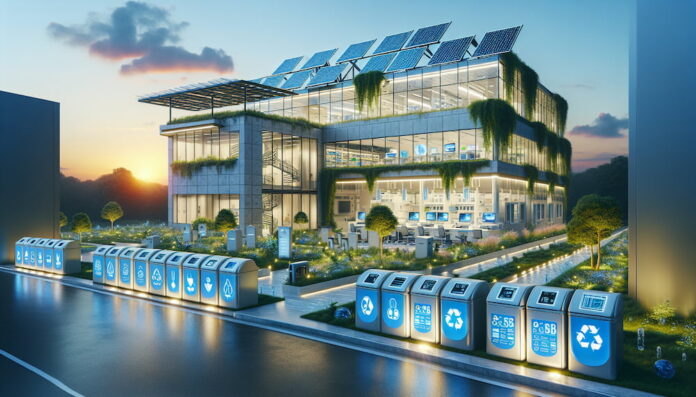Within the intricate framework of healthcare, laboratories emerge as pivotal hubs for innovation, diagnostics and research. Often overlooked yet indispensable to health and well-being, managing these facilities entails navigating a complex array of safety protocols, sustainability initiatives and operational efficiencies simultaneously. Engaging the services of reputable facilities management providers such as a trusted facilities services provider can significantly streamline these challenges, ensuring that laboratories function effectively, sustainably and safely.
Exploring the Importance of Sustainability in Laboratory Operations
Sustainability has become a focal point in various sectors, including healthcare laboratories. Due to their significant consumption of energy, water and disposable resources, laboratories have a notable environmental impact. Embracing sustainable practices reduces this impact leads to cost savings and improves worker safety. Simple adjustments, like transitioning to energy-efficient equipment and implementing recycling programs, can significantly enhance environmental stewardship.
Additionally, sustainability in laboratory operations signifies a commitment to future generations. The healthcare sector has a responsibility to lead by example, showing that exceptional care can harmonize with environmental responsibility. As a result, laboratories increasingly adopt green chemistry principles, reducing reliance on hazardous substances and exploring renewable energy sources. These initiatives demonstrate a forward-thinking approach, aligning scientific excellence with environmental preservation imperatives.
Prioritizing Safety in Laboratory Maintenance
Despite the momentum towards sustainable practices, safety remains paramount in laboratory operations. Routine safety assessments are indispensable, serving as vital checkpoints to identify potential hazards and ensure adherence to rigorous industry regulations. In addition, equipping personnel with appropriate emergency response training significantly mitigates accident risks.
Integral to maintaining a safe laboratory environment is the proper disposal of hazardous waste, a process that, when executed responsibly, complements sustainability endeavors. Meanwhile, regular audits and ongoing training sessions reinforce safety protocols, promoting a culture of vigilance and preparedness among lab staff. Moreover, continuous refinement of safety protocols based on incident analysis enhances proactive risk mitigation strategies, ensuring a resilient safety framework.
Harnessing Technology for Efficiency and Sustainability
Technological innovations serve as catalysts for achieving operational efficiency and sustainability in laboratories. Automation, for instance, minimizes manual errors, conserves time and reduces consumable resource utilization. Additionally, energy-efficient appliances substantially curtail electricity consumption. Beyond hardware, software solutions for resource tracking and management facilitate waste reduction and workflow optimization, promoting safety and environmental responsibility.
Continuous research into emerging technologies ensures labs stay at the forefront of efficiency and sustainability advancements, maximizing their impact on operational effectiveness and environmental conservation. Lastly, the integration of predictive maintenance technologies enhances equipment reliability, minimizing downtime and optimizing resource utilization for sustainable operations.
Crafting a Robust Maintenance Schedule
Developing a maintenance regimen tailored to the unique requirements of healthcare laboratories is indispensable for uninterrupted functionality. Routine equipment inspections and calibration are vital for maintaining diagnostic and research accuracy; however, beyond technical considerations, this schedule should incorporate insights from laboratory personnel possessing invaluable frontline perspectives. Their input can illuminate potential enhancements in safety and sustainability practices.
Collaborative workshops and knowledge-sharing sessions empower staff to actively participate in optimizing maintenance schedules, encouraging a sense of ownership and accountability towards lab safety and sustainability goals. Moreover, iterative refinement of maintenance protocols based on feedback loops ensures continuous improvement, nurturing a culture of excellence and adaptability within the laboratory ecosystem.
Fostering Collaborative Partnerships for Environmental Conservation
Partnerships play a pivotal role in advancing sustainability agendas within laboratories, where collaborating with eco-conscious suppliers for laboratory materials significantly mitigates environmental impact. Furthermore, laboratories can extend their influence beyond their confines through community engagement, raising awareness about sustainability and promoting eco-friendly practices.
Embarking on the journey towards greener laboratories entails more than adopting novel technologies or practices. It represents an ongoing voyage of learning, adaptation and innovation; by prioritizing safety and sustainability, healthcare laboratories can bolster operational efficiency and contribute to environmental well-being. Acknowledging that progress in sustainability is incremental and necessitates collective action constitutes the initial stride towards safer, more sustainable laboratory management in the healthcare sector.
Did you find this helpful? Check out our other helpful articles on our website.
Read Also
- Affordable and Effective Coquitlam Braces with My ORTHODONTISTA confident smile is more than just a set of straight teeth—it’s a reflection of self-esteem, health, and happiness. For families in Coquitlam, finding braces that are both affordable and effective can sometimes feel like a challenge. That’s where My ORTHODONTIST steps in, offering trusted orthodontic care that helps patients achieve beautiful smiles without breaking… Read more: Affordable and Effective Coquitlam Braces with My ORTHODONTIST
- How to Choose the Right KOL Management Platform for Your Medical Affairs TeamSelecting the right KOL management platform is no longer just a tactical decision, it’s a strategic one. That’s because the platform you choose influences how effectively your medical affairs team identifies key healthcare professionals, engages with them, and sustains long-term scientific relationships. With multiple KOL management companies and technology vendors offering varying levels of data,… Read more: How to Choose the Right KOL Management Platform for Your Medical Affairs Team
- A Guide to Senior Behavioral Health: Supporting Aging Minds With CareWhat keeps the mind strong and healthy in later years of life? Aging brings unique changes that affect how older adults think, feel, and connect with others. Mental and emotional health often play a key role in overall well-being. Seniors may face stress, sadness, or confusion due to life transitions. Family and caregivers may sometimes… Read more: A Guide to Senior Behavioral Health: Supporting Aging Minds With Care
- Transforming Mental Health Care: Embracing Remote Therapy for Michigan ResidentsThe Digital Shift in Mental Health Services The therapy landscape has been rewired by technology at a speed that would make any traditionalist blink. According to the American Psychological Association, nearly 96% of psychologists reported providing telehealth in 2020, compared to just 7% the previous year. That surge wasn’t a fad—it was an overdue modernization.… Read more: Transforming Mental Health Care: Embracing Remote Therapy for Michigan Residents
- How Pilates Certification Enhances Professional Growth in HealthcareAre you looking for a way to expand your skills and stand out in healthcare? Pilates certification can be a powerful step in your professional journey. It not only helps you understand movement and body mechanics. It also gives you tools to support patient recovery. It also improves mobility, and promotes wellness. Ready to see… Read more: How Pilates Certification Enhances Professional Growth in Healthcare
- The Role of Community in Assisted Living: Enhancing Quality of LifeHave you ever thought about how being part of a community can make life better in assisted living? Living near friendly neighbors and caring staff gives you more than safety-it brings friendship, fun, and shared moments. Joining in activities, events, and daily routines helps you feel happy, active, and valued. Being part of a group… Read more: The Role of Community in Assisted Living: Enhancing Quality of Life
- Choosing the Right Dental Veneers for Enhanced Aesthetic AppealA bright smile can boost your confidence. If you want a quick way to improve your teeth, dental veneers may be the answer. They can hide stains, chips, or gaps and give you a natural look. But with many choices, it can be hard to know what is right for you. In this post, we… Read more: Choosing the Right Dental Veneers for Enhanced Aesthetic Appeal
- How Self-Heating Eye Compresses Revolutionize Dry Eye TreatmentHave you ever experienced eyes that feel dry, irritated, or constantly tired? Dry eye syndrome has become increasingly prevalent due to prolonged screen time, environmental factors, and the aging process. Many people struggle to find relief that is both safe and effective. Traditional eye drops often bring only temporary comfort. Warm compresses work well but… Read more: How Self-Heating Eye Compresses Revolutionize Dry Eye Treatment









